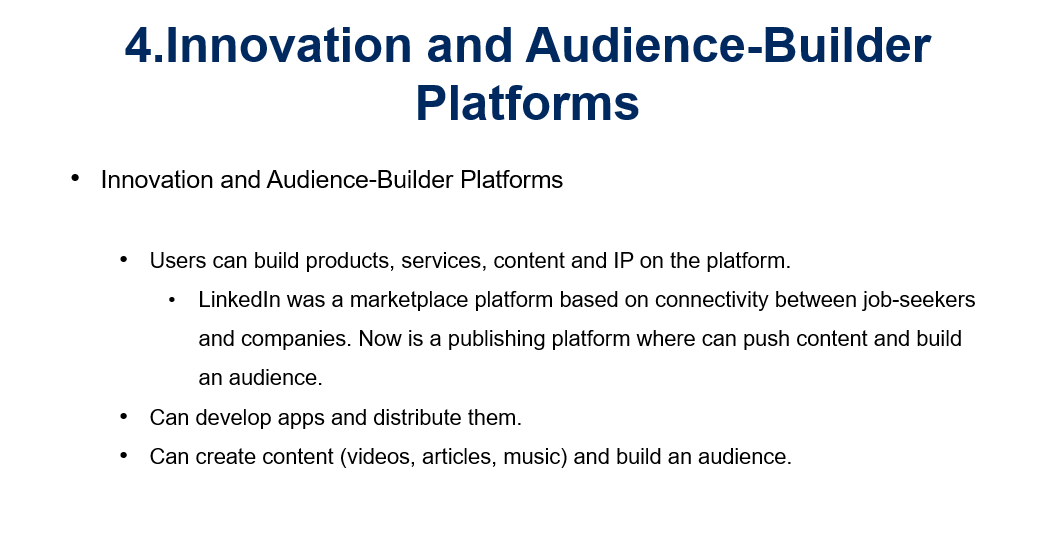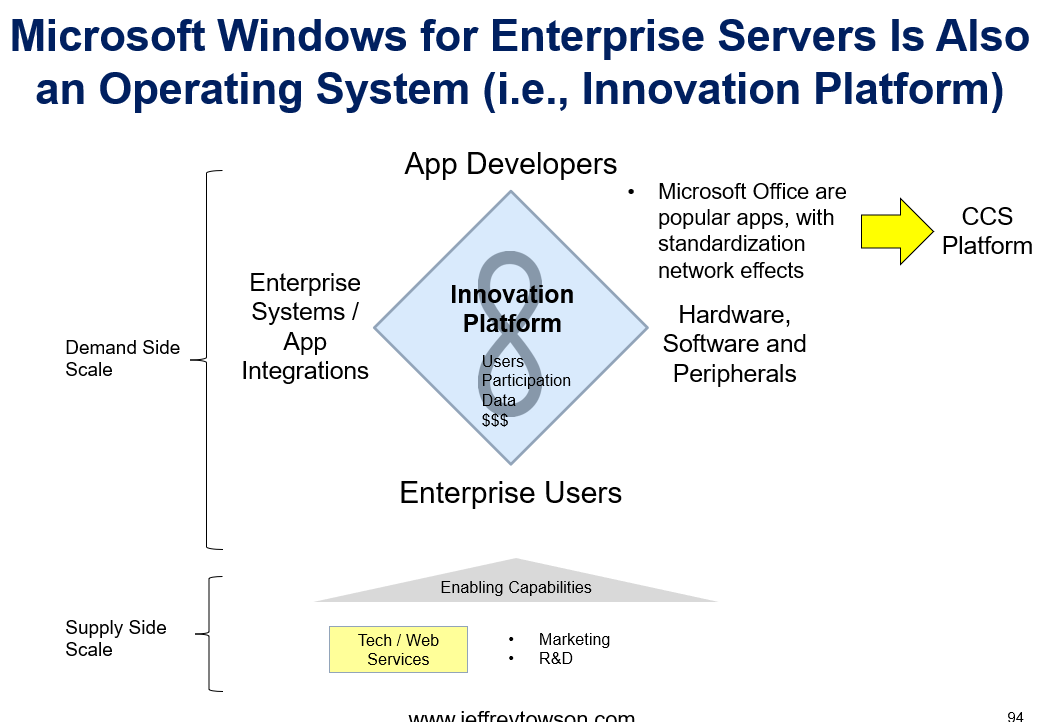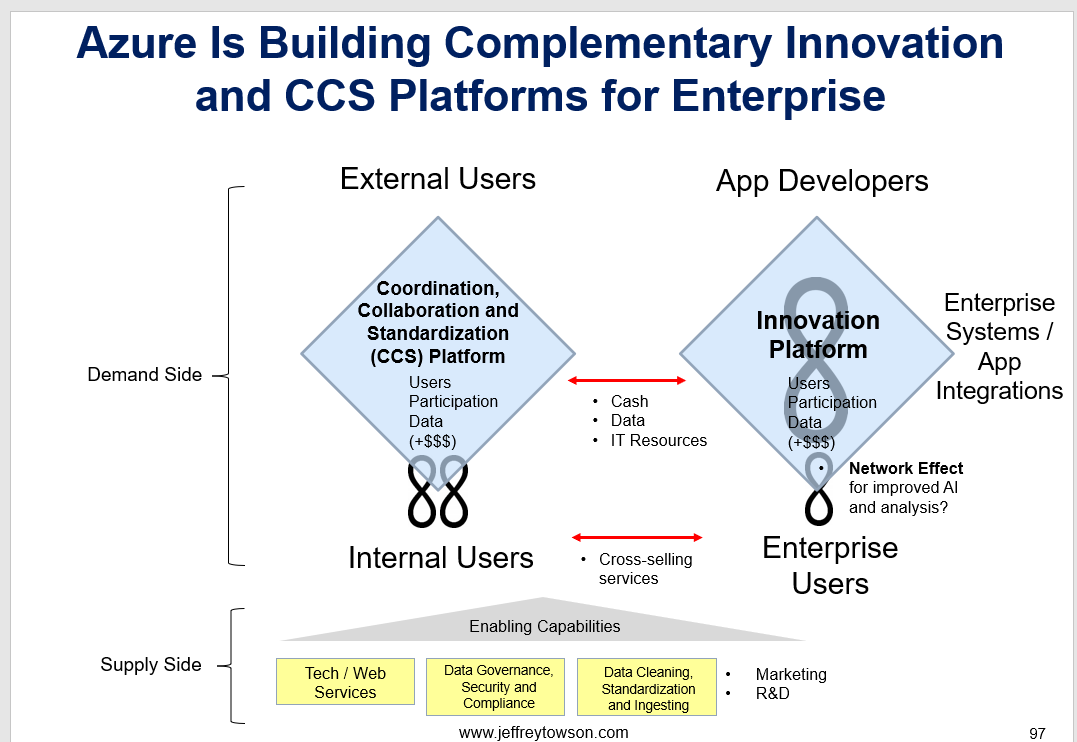I’ve been looking a lot at Microsoft. It’s a really compelling digital business model. Like stunningly powerful.
But it’s pretty confusing. Microsoft has an endless list of products and services. And so many user groups (consumers, enterprises, SMEs, developers, etc.). And, of course, so many types of revenue. For example, here are Microsoft’s major revenue sources for 2022:
- Server products and cloud services (34%)
- Office products and cloud services (22%)
- Windows (12%)
- Gaming (8%)
- LinkedIn (8%)
- Search advertising (6%)
- Enterprise services (4%)
- Devices
- Other
And this is a big hint.
When I see lots of completely different revenue streams, it usually means the company is not just creating value just by selling products or services. It means they are also creating value by enabling connections and interactions. They are in the pipeline and the ecosystem business. Platforms and ecosystems can generate completely different revenue streams from lots of different areas. Coca-Cola, in contrast, doesn’t have 10 different types of revenue streams.
Traditionally, Microsoft was always a mixture of digital services (i.e., a pipeline) and a platform / ecosystem. They created products and services (Word, Excel, PowerPoint) but also enabled interactions (lots of app developers writing for Windows). And they used this model to completely dominate personal computers. And to a lesser degree on-premise enterprise services.
Fast forward to today and Microsoft is all about the cloud. And their business has evolved into something more complicated. They are investing like crazy. They are building data centers. And they are doing regular acquisitions. For example, GitHub, LinkedIn, lots of video games, etc.
***
I think this is all relatively understandable if you have the right picture of Microsoft’s business model. In fact, I think their acquisitions and other projects are pretty predictable. In these two articles, I’ll give you my version of what they are building for the cloud.
Old Microsoft Was “One Platform Plus Some Apps”
For most of the 1990’s, Microsoft was Windows plus Office. And it was a global monopoly with stunning marketshare. It represented over 50% of all the global revenue in the productivity software industry.
In terms of business models, we can describe it mostly as an innovation platform. Recall, my definitions for Innovation Platforms.

And we can do a basic graphic for Windows as an innovation platform (i.e., an operating system).

That’s Windows on personal computers. The users of the personal computer are one group. The app developers are the other. And the more app developers creating things, the better the service (i.e., a network effect).
And you can see Microsoft Office as 3 particularly popular apps on this platform, which Microsoft owns and profits from. These also have standardization network effects and are interesting in themselves. They are sold as an integrated bundle (something I talk about as a Soft Advantage). Microsoft kept the most attractive (and strategic) apps for itself.
Ok. Fine. But then we move to the Enterprise-side, which is much more interesting. it looks like this.

At the center, we see the same innovation platform, with two user groups and a network effect. But you can notice two important changes.
- First, you can see the integration with other Enterprise apps and systems. This is why B2B is so much more sticky than B2C. Everything becomes embedded and interconnected in the workflows of enterprises.
- Second, you can see that Microsoft Office is starting to become more collaborative. It was eventually re-named Office 365. And then later Microsoft 365.
This second point is really important. Microsoft’s suite of productivity tools increasingly became places for collaboration and coordination within enterprise. As opposed to remaining stand alone tools people used as apps. More on this in New Microsoft.
A final point.
Enterprise also means using open source, which is another source of developer innovation and support. I consider this a capability to be drawn upon.

Why New Microsoft Is “Two Platforms Plus Cloud Infrastructure”
Then we move from personal computers and on-premise enterprise to the cloud. Really to multi-cloud and an edge computing network as the new computing and connectivity infrastructure. It’s what everyone is starting to build things on.
The first point on this is that most of what Microsoft, AWS and Google Cloud are doing right now is building infrastructure. That’s why Microsoft is opening +200 data centers, investing in tons of AI and other tools and supporting tons of IoT devices. It’s about putting the cloud infrastructure in place.
The benefits of global cloud infrastructure are typically cited as:
- Flexible usage
- A massive suite of capabilities and tools
- Global reach
- Security
- Compliance
- A global support network
And other stuff. And for most large enterprises, the future is probably to have their operations multi-cloud and hybrid.
But this is not really that interesting. What is interesting are the two powerful platforms Microsoft is building on top of this new cloud infrastructure. Hence my argument that new Microsoft is “Two Platforms Plus Cloud Infrastructure”.
The first is another Innovation Platform.
Basically, it’s the operating system on Azure. Just like mentioned above. This is the platform that all the developers will create apps that run on.
The second is a Coordination, Collaboration and Standardization (CCS) Platform. Recall my definition of this.

And I generally talk about 4 types of CCS platforms.

- Doesn’t that sound like what I just said Office 365 (now Microsoft 365) is turning into?
- Doesn’t that sound a lot like Microsoft Teams?
- Doesn’t the word “teams” imply collaboration?
Take a look at what Microsoft Office has evolved into:

Team collaboration, project management, StaffHub, Bookings, Skype for Business, Microsoft Teams, etc.
Look at my list of 4 types of CCS platforms again (communication, data intelligence, team projects, operational automation). We can see a lot of those in this list.

That’s the second platform. And we can put this together for a picture of Azure.

That is what Azure looks like to me. Two platforms plus a lot of infrastructure. And they are building lots of enabling capabilities in:
- Tech / web services
- Data governance, security, compliance
With this in mind, take a look at how Microsoft describes Azure.
“Microsoft 365, Dynamics 365, and the Power Platform, on top of what we’re doing with Azure, is the core of what we are doing as a company.” –Satya Nadella CEO, Microsoft
And here is how they show it:

You can see the infrastructure in the bottom. The security, compliance, etc. And then Microsoft Azure as the cloud and edge network.
The next level up is GitHub and Power Platform. I’ll explain these in Part 2, but these are all tools for developers to create apps for the system. That’s the innovation platform.
The top layer is Microsoft 365, LinkedIn and Microsoft Dynamics 365. This is the collaboration platform. And this is what Office has evolved into. I’ll detail that in Part 2 as well. Plus, I’ll go into Microsoft’s major initiatives and acquisitions. They all fit nicely in the graphic I just presented.
Cheers, Jeff
——–
Related articles:
- Microsoft’s 3 Big Upgrades to its 2 Platform Business Models (2 of 2) (Tech Strategy – Daily Article)
- What is Elon Musk’s Plan to 10x Twitter? (2 of 2) (Tech Strategy – Daily Article)
From the Concept Library, concepts for this article are:
- Innovation Platform
- Coordination (CCS) Platform
- Cloud Services
From the Company Library, companies for this article are:
- Microsoft: Azure
Photo by Ed Hardie on Unsplash
———-
